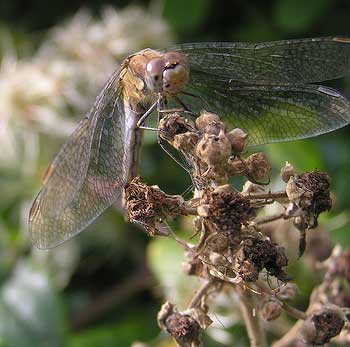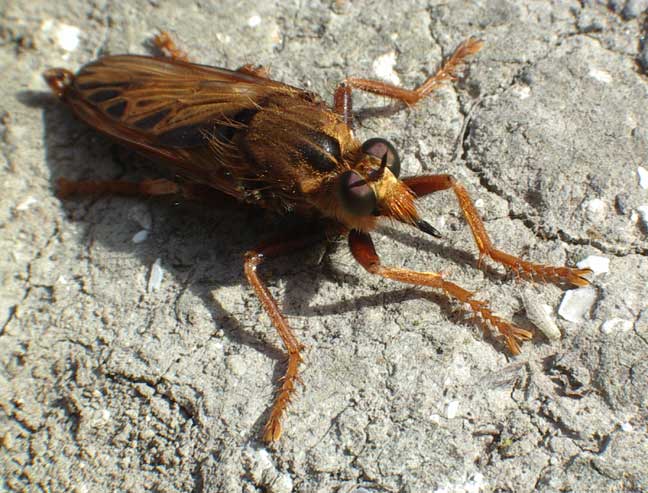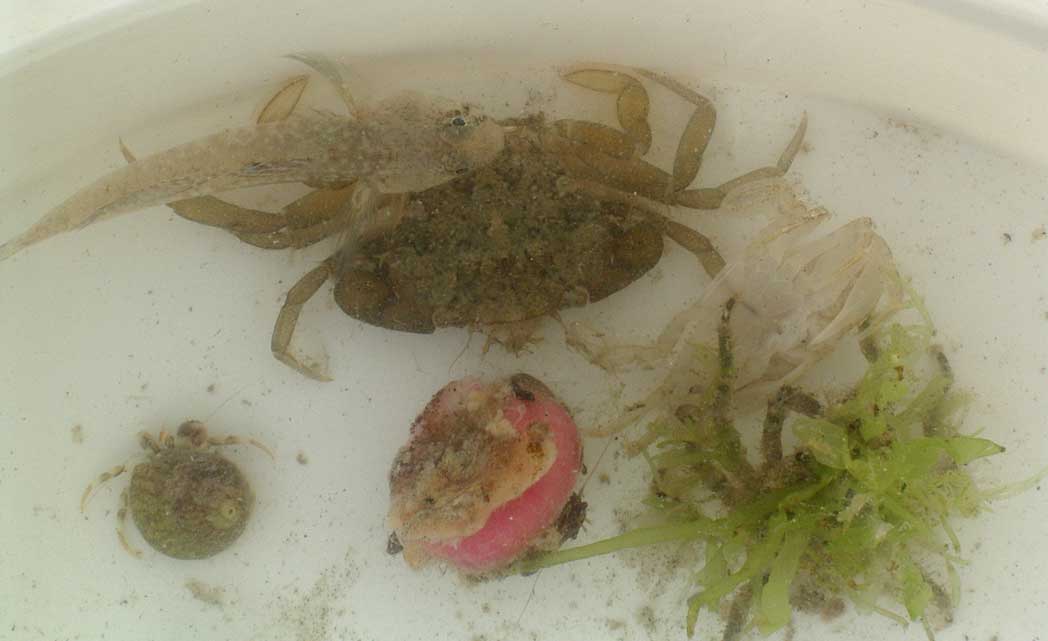| NEWS
AND EVENTS
16
September 2004
Leisure
& Resources Adur District Council
Committee
meeting
Management
of Mill Hill and Lancing
Ring
The
Councillors passed the inadequate Management Plan prepared by the South Downs Conservation Board for Mill Hill, but rejected the plan for Lancing
Ring.
17
August 2004
PUBLIC
MEETING
Management
of Mill Hill and Lancing
Ring
Lancing
Parish Hall, South Lancing
7:00
pm
This
is the Public meeting to proceed the Scrutiny Meeting*
decided
by an Adur Council Committee meeting on 4
May 2002. (*
It
is possible that the Council will try to ignore this Committee decision.)
WILDLIFE REPORTS
31
August 2004
 The
large hoverfly Volucella
zonaria was nectaring on Ivy near
the Butterfly Copse next to the Waterworks Road. The
large hoverfly Volucella
zonaria was nectaring on Ivy near
the Butterfly Copse next to the Waterworks Road.
More
Images
Adur
Hoverflies
Another
small Vernal Crab,
Liocarcinus
vernalis, was discovered on the beach
opposite Brooklands Boating Lake on the low spring tide.
Adur
Low Tide Reports
The
butterfly
season looks like coming a close with very few flowering plants on Mill
Hill, apart from Stemless
Thistle and Carline
Thistle attractive to them. Adonis
Blues and Common
Blues were around on the lower
slopes in about equal numbers, about a dozen males each with the brown
females hiding in the grass and the same number of Chalkhill
Blues which were battered and worn. There
were at least two Brown Argus Butterflies
on the lower slopes with 20+ Small Heaths
and
few Small Whites. A
handful of Speckled Woods
were seen amongst the scrub.
30
August 2004

A Brown
Hawker (dragonfly)
was seen just west of the cemetery below Lancing
Ring. This is the first record on these
Nature Notes web pages.
29 August
2004
A
Roe
Deer was spotted in a crowded McIntyres
Field (to the east of Lancing Clump) on a
day when I nearly stepped on an Adder.
Autumn Ladies
Tresses Orchid, Spiranthes spiralis,
were in flower in the chalkpit.
26
August 2004
The second
brood Adonis Blue Butterflies
were out on Mill Hill: a count of 29 males were recorded, all on the lower
slopes. A similar number of at least 29 Chalkhill
Blues
were also out on the lower slopes of Mill Hill. The commonest butterflies
were the Small Heaths
with fifty plus. Other species included Meadow
Browns,
Common
Blues,
Holly
Blues, Speckled Woods
and Small Whites.
Adur
Butterfly List 2004
Adonis
Blue Butterfly (male)
The
deluge of two days ago may have contributed to the appearance of three
mushroom species.
Fungi
Report
Fungi
of Shoreham
25
August 2004
 A
Southern
Hawker (dragonfly), Aeshna cyanea,
caught a Small White Butterfly in
flight, captured and held it, found a perch and then ate it on Lancing
beach in a process that took about three minutes. An immigrant
Painted
Lady Butterfly was resting nearby. A
Southern
Hawker (dragonfly), Aeshna cyanea,
caught a Small White Butterfly in
flight, captured and held it, found a perch and then ate it on Lancing
beach in a process that took about three minutes. An immigrant
Painted
Lady Butterfly was resting nearby.
Full
Report and Extra Images
24
August 2004
The
black Cumulonimbus
clouds moved over quickly, the thunder rumbled and the downs were obscured
and the heavy rain squalls lasted for about ten minutes, and then the sky
cleared. (Image) Later
the heavy showers increased in duration. The rain total for the day was
20.32 mm (cf. 53.8 mm on 12
October 2000 and 26.42 mm on 7
July 2004).
Shoreham
Beach: Monthly Weather Summaries
It
was at the start of one of these brief deluges that a Sparrowhawk
swooped
in a swift arcing flight over a garden in The
Drive, Shoreham, (near Buckingham Park). This is the second time that this
raptor has been seen in this garden.
Full
Report
22
August 2004
 In
Oxen Avenue, residential area of Shoreham, the
first
Clouded Yellow Butterfly of
August fluttered northwards, the black edge to the yellow wings distinctive.
Often when I see one there would be more on the downs
but in the late afternoon there wasn't any more
Clouded
Yellows, and the only other immigrant was
a Painted Lady Butterfly
with the resident butterfly species, including Wall
Browns, and other insects including a
female
Emperor Dragonfly. In
Oxen Avenue, residential area of Shoreham, the
first
Clouded Yellow Butterfly of
August fluttered northwards, the black edge to the yellow wings distinctive.
Often when I see one there would be more on the downs
but in the late afternoon there wasn't any more
Clouded
Yellows, and the only other immigrant was
a Painted Lady Butterfly
with the resident butterfly species, including Wall
Browns, and other insects including a
female
Emperor Dragonfly.
Adur
Damselflies
and Dragonflies
Adur
Butterfly and Large Moth List 2004
A Hornet
Robber Fly, Asilus
crabroniformis, (a Biodiversity
Action Plan species), a rare rather menacing looking large flying predatory
insect associated in this case with horse's
dung and reputed to prey on the dung insects,
settled on the path (the footpath from the
Waterworks
Road next to the Horse's Fields on the way to Mill
Hill) in front of me, the second one of
these flies I had seen in the last few days. It is a strong flyer.

Hornet
Robber Fly (More Information)
21
August 2004
Birds
everywhere are on the move, with flocks of Starlings
of over one hundred over the Hasler Estate (north of Widewater) and three
Wheatears
flying around Widewater car park east, before
embarking on their long migration south.
Wheatears
at New Erringham
c.
20 August 2004
Whilst
night diving at Shoreham beach, West Sussex I found a bright banded orange
and white prawn. It was spinning around proabaly to avoid my torch light.
This appears to be one of the Prosseca
species which are seen at night. They lack the pronounced rostrum of the
abundant Palaemon
species of prawn.
Image
Sussex
Marine Life Reports
Adur
Intertidal
19
August 2004
Just
the second magnificent site of a female Emperor
Dragonfly this year, flying to and fro
under the canopy of the Butterfly Copse (TQ
209 063) near the Waterworks
Road, with over a dozen Common Darters
being slightly furtive. Another large blue dragonfly was seen which was
probably a Southern Hawker Dragonfly (but
the identity could not be confirmed). A few
brighter Red Admirals
and a Painted Lady
were around in a year that has seen very few migrant butterflies.
Adur
Damselflies
and Dragonflies
Adur
Butterfly and Large Moth List 2004
17
August 2004
.jpg)
A
Chalkhill
Blue Butterfly and Clouded
Yellow Butterfly are photographed
on Lancing Ring meadows.
An
Adonis
Blue
Butterfly is recorded and both males and
females are photographed, the first time this butterfly has been recorded
from the Lancing Ring meadows.
16
August 2004
I
visited the upper slopes of Mill Hill
for the primary purpose of photographing the underwings of the small brown
blue butterflies to make sure I had identified the female
Common Blue Butterflies
and the Brown Argus
Butterflies correctly.
 |
 |
|
Female
Common Blue
|
Brown
Argus Butterfly
|
The
underwing views confirmed my original identifications (on
the underside hind wing of the Brown Argus two of the spots line up to
form a colon). The Brown
Argus Butterflies were usually smaller, although
occasionally very small Common Blue Butterflies
occurred.
More
Images
Eleven
species of butterfly were recorded on Mill Hill and a total of thirteen
different species for the day.
Adur
Butterfly and Large Moth List 2004
15
August 2004
Butterfly
Walk on Lancing
Ring
Brianne
Reeve led the walk which started at 11:00
am, 30 minutes later than planned because
of the continual rain and was of restricted duration and length, just skirting
the meadows to the west of Barton's Wood, and never even approaching Lancing
Clump itself, and in between the repeated showers, the walk was not noted
for its butterflies, it was nevertheless
interesting in a lot of respects.
Noteworthy
observations included a handful of Brown
Argus Butterflies, the first time these
had been observed in these meadows: they appeared grey in flight (more
like a Small Blue)
and all the butterflies observed lacked the white in the lunules underneath
the orange rim spots on the upper wing (which occur on the very similar
female
Common
Blue Butterflies, which appears orangey
or blue-brown-blue in flight).
Brown
Argus Identification Notes
 |

|
|
Brown
Argus
|
Female
Common Blue
|
Other
things of Interest were a few both male and female Wasp
Spiders, with the female in the centre
of the web and the smaller male nearby, and in an area where they had not
been seen before; a Magpie Moth,
and at least six other species of common butterflies.
Adur
Wasp Spiders
Adur
Butterflies
The
very best sight was left to last when Ray
Hamblett discovered a Common
Toad in a hole, in the middle of a flowery
meadow.
More
Images of Lancing Ring (by Brenda Collins)
13
August 2004
At
least two, and probably many more, Migrant
Hawkers, Aeshna
mixta, flew over St. Michael's churchyard
in Southwick. These impressive dragonflies
cruised around, much too rapidly to photograph, at head height and above.
Twelve
species of butterflies were recorded on an
unfavourable day with a Strong Breeze approaching
Gale Force on the downs and rain showers.
Adur
Butterfly and Large Moth List 2004
11
August 2004
A
large blue dragonfly was hawking over the Willow
Tree area (behind the Withy Patch) of New Monks
Farm, Lancing. At first I thought it was an Emperor
Dragonfly because of its size, but the markings
were more black than blue, so I think this must be a Migrant
Hawker,
Aeshna
mixta.
Adur
Damselflies
and Dragonflies
10
August 2004
The
dearth of the Vanessid butterflies
has been so marked by the scarcity of the Red
Admirals, Small Tortoiseshells,
Peacocks
and
Painted Ladies
this year that it is being remarked on by the general public. This is occurring
all over England, with just a few exceptions.
Adur
Butterfly List 2004
Adur
Butterflies
The
early morning (8.00 am)
temperature was 19.6 ºC with a humidity of 93% with not even a breeze
(Light Air, Force 1) and light rain at 1.5 mm
an hour. The early morning Heat
Index was 22.9 ºC. (The Heat Index caution level is above 25 ºC.)
9 August
2004
A
Little
Egret is seen feeding by Old Shoreham
Toll
Bridge.
NB: Little
Egrets are now a regular bird seen feeding
on the River Adur estuary and there is usually
one or more on Widewater Lagoon.
8 August
2004
 At
the top of The Drive (opposite Buckingham Barn on the south
A27 road bank), a grey Small Blue Butterfly
was seen, possibly the same one seen on 25
July 2004. This second brood Small
Blue is a notable record. At
the top of The Drive (opposite Buckingham Barn on the south
A27 road bank), a grey Small Blue Butterfly
was seen, possibly the same one seen on 25
July 2004. This second brood Small
Blue is a notable record.
Adur
Butterfly List 2004
Adur
Butterflies Flight Times
A woman
was stung by a Weever Fish,
Echiichthys
vipera, whilst bathing off Shoreham Beach.
Beware
of the Weever
Adur
Intertidal
Sussex
Marine Life Reports 2004
The
temperature reached 28.8 ºC during the day.
7
August 2004
In
a heatwave (25.3 ºC),
it was disappointing as I seemed to have missed the peak for the emergence
of the Chalkhill Blue Butterflies
this year. On the lower slopes of Mill
Hill; my estimated count was about 175 evenly distributed over the
slopes with a few in the long grasses on the top, giving a total number
of about 500.
 |
 |
As
a bonus there were plenty of other butterflies
around, including a few Brown Argus
Butterflies, my first confirmed sighting
of this species from Mill Hill, the absence of white lunules nearer than
the linear orange spots to edge of the upper wing distinctive and separating
these from the female Common Blue Butterflies.
Male
Common Blue Butterflies exceeded one hundred
in the long grasses, mostly north of the car park. At the northern end
of the lower slopes a pristine Adonis Blue
was immediately distinctive from the Chalkhill
Blues, which were all worn and battered to
some extent. Wall Browns
numbered about ten mostly just south of the reservoir where the Cocksfoot
is, it was difficult to be sure of their numbers with their repeated sparring
with the Meadow Browns. Small
Heath Butterflies were frequently seen,
and their numbers must have been underestimated before. Fifteen species
of butterfly were seen around midday. A Red
Admiral Butterfly was added to the list
in the early evening.
Mill
Hill Nature Reserve
Adur
Butterfly List 2004
Adur
First Butterfly Dates 2004
Brown
Argus Identification Notes
About
3:30
am in the night, a Red
Fox was seen my south Lancing front garden
(TQ
186 044) and its eerie call which sounds like
a strangled pheasant.
Early
August 2004
A
Swallowtail
Moth, Ourapteryx
sambucaria, was a surprise and colourful
observation at the western end of Widewater
Lagoon. This spectacular moth may be regarded as nothing special by
moth enthusiasts, but to the ordinary nature spotter it is an unusual and
usually unrecognised insect when first seen. This is the first report on
these Nature Notes pages of a nocturnal native
moth with a short flying time in July.
Report
by David Wood
2 August
2004
For
investigative purposes I visited Anchor Bottom,
(Dacre Gardens entrance), near Upper Beeding, for a comparative look at
the lower part of this downland, which in historical times, before the
"improvement" and cattle gazing, had a reputation for butterflies.
Dodging the cow pats in the long coarse grasses, I observed just a dozen
butterflies of four species, including one smaller than usual Chalkhill
Blue.
I
also visited the Slonk Hill North road embankment
which contains an expanse of more upright Horseshoe
Vetch which is within the dispersal
area of Mill Hill Chalkhill Blues,
but despite being established for over 30 years, this area was noted by
a complete absence of butterflies and no Chalkhill
Blues, not even a vagrant was seen.
In
contrast a small garden plot sized area of road embankment south-east of
the bridge, over the by-pass, to Mill
Hill contained twenty male Chalkhill Blues.
The
conclusions I drew were:
1)
The plan to reintroduce Chalkhill Blues
to the road embankment has failed in a 30 year time frame, despite a vast
expanse of Horseshoe Vetch.
The establishment of Small Blues
has succeeded in the same time.
2)
Anchor Bottom (SSSI) has been destroyed as a worthwhile butterfly site
(from 1950 onwards).

3)
60% of Mill Hill has been destroyed
by ecological succession into woodland and a further 25% has been destroyed
by a mixture of scrub, cattle grazing and human activity; all occurring
during my lifetime. This has the result of reducing the population of Chalkhill
Blues
on Mill Hill in 1960 from my estimate
of up to 40,000 Chalkhill Blues
to an absolute maximum of 6,000 nowadays and this could be considerably
less as the maximum daily total I have recorded is 3,000.
1 August
2004
Afternoon
The
beach between Worthing and Lancing seems an unpromising area for rockpooling
but it consistently provides a variety of some of the less usual small
fish and crabs found between the tides. Katherine
Hamblett and
Tacita French discovered a young first year
Worm
Pipefish, Nerophis
lumbriciformis, which is unusual this
far east up the English Channel. There were unusual
crabs
as well as more common crustaceans like small Common
Hermit Crabs, Pagurus bernhardus,
and Squat Lobsters, Galathea squamifera.

|
 |
Star
Ascidian on a rock
Botrylloides
schlosseri
A
colonial tunicate or sea-squirt
|
Click
on the image for more information about the critters in the bucket
|
The
itinerary of discoveries on the low spring tide
can be found on the bucket page. The swimming
crabs Liocarcinus vernalis and
Liocarcinus
arcuatus have been identified, with
one specimen of the small Short-legged
Spider Crab, Eurynome
aspera, several small Long-legged
Spider Crabs, Macropodia
sp.,and
Hairy Crabs,
Pilumnus
hirtellus.
Full
Report
Adur
Intertidal Seashore
BMLSS
Intertidal Crabs
Halfbricking:
Bucket of Critters
Kingston
Buci Beach 2004
Morning
By
far the largest Slow Worm
I have ever seen was basking on the chalk path that leads down to the lower
slopes of Mill Hill. Coiled, it completely
covered the path, and it must have sensed the vibrations of my approach,
as it uncoiled and slid off into the wayside scrubbery, revealing its length
to be at least 30 cm.
On
the lower slopes, I must a have missed a few emergences and the Chalkhill
Blue Butterflies I attempted to count
and eventually arrived at a estimate of about 225
on the half transect ramble. This would make me estimate about 600
Chalkhill Blues on the hill. They were already
beginning to disperse. Females were frequently discovered but they could
be outnumbered by about ten to one by the blue males. Many of the Chalkhill
Blues were worn, not yet frayed at the edges,
but none seemed to be in new pristine condition. A few of the Chalkhill
Blue Butterflies
had an extensive brown tinge on the wings. The total number of butterflies
on the hill actually seen exceeded 300. Fifteen different species of butterfly
were seen during the day. Two second brood Brimstone
Butterflies were on the lower slopes of
Mill Hill, although one was in the scrub to
the north.
Adur
Butterfly List
A Green
Woodpecker
flew arrow-like along the top of the ridge calling loudly.
Lower
Slopes of Mill Hill 2004 (Link) |